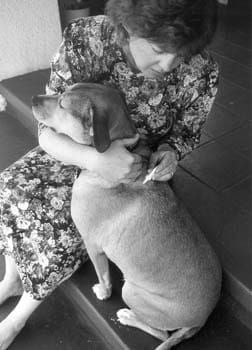By CJ Puotinen
Your nagging feeling was right – there really is something wrong with your dog. And it’s not just a pulled muscle or a torn toenail. It’s cancer.
As you struggle to wrap your mind around that diagnosis, the veterinarian describes your options: surgery, radiation, or chemotherapy, alone or in combination. Or your dog might be eligible to participate in a clinical trial testing a new drug, or you may want to consult an oncology specialist or consider a promising new state-of-the-art treatment. There are no guarantees that any of these treatments will work, and if the prognosis is especially grim, you may want to say goodbye now. Please decide within 24 hours. This is a medical emergency.

No wonder a Morris Animal Foundation survey found that the number-one fear of American pet owners is cancer.
You struggle to comprehend median survival times, treatment plans, treatment side effects, quality of life issues, and the demands that different protocols will make on your schedule – not to mention your checkbook.
Meanwhile, your faithful companion stares at you with trusting eyes.
“A cancer diagnosis is an incredibly emotional experience,” says Gerald Post, DVM, ACVIM, who has specialized in pet cancer care for 15 years. “There’s so much to consider, and there is a huge element of uncertainty. Even when you use the most accurate statistics for a particular group of animals with a particular type of cancer that is treated in a specific way, there is no way to know how your particular dog, who’s in the treatment room right now, will respond. When it comes to dogs and cancer, there are still many unknowns.”
So how can one make informed decisions?
“You have to consider all the factors,” he says. “At our clinic, we start with the diagnosis and then discuss what the cancer’s biological behavior is, what tests are needed, and what can be done. To answer this last question, we look at conventional therapies that are already widely used and experimental therapies that are ongoing. We include what our experience has taught us about probable outcomes, what the owners want, and how the dog is feeling. All of this information helps narrow the choices so that the owner can consider the most promising options.”
Survival rates
When it comes to cancer, some types are better than others – better meaning that they have a higher survival rate and are easier to treat than other cancers.
“The ideal patient in any oncology practice is one that doesn’t have cancer,” says Dr. Post. “That’s the best situation of all. But among cancer patients, I’d be happy if all of mine were otherwise healthy middle-aged dogs, each with a small (less than 3 centimeters) mast cell tumor on his or her body. These dogs can handle surgery very well, and they are likely to make a full and complete recovery.”
At the opposite end of the spectrum are patients with worst-prognosis cancers. “Whenever a young dog comes in with acute leukemia, or a middle-aged Golden Retriever has just been diagnosed with a ruptured splenic hemangiosarcoma, you can’t help but feel heartsick. These are difficult, difficult cases.”
Dr. Post says that osteosarcoma used to be in that category, “but we’re making progress there. It’s still a horrible disease, and sometimes we do have to amputate a leg, but with chemotherapy, we can increase survival time to a year or sometimes longer. A year is a fairly long time in veterinary oncology, and those 12 months are very precious to the dog’s human family.”
In human medicine, cancer patients are considered cured if they go for five years without the disease. While veterinary medicine doesn’t formally define the term, Dr. Post considers any dog who goes for more than two years without a malignancy to be cured.
Conventional treatments
In conventional medicine, surgery remains the most widely used and most effective treatment for cancers that cause solid tumors. It can be used by itself to remove a tumor, or it can be used in combination with chemotherapy, radiation therapy, or other treatments to enhance their effectiveness.
In many cases, tumors are removed along with a margin of tissue surrounding the tumor. Radical surgery, such as amputation, has a longer recovery time and more potential complications than minor surgery. However, improvements in anesthesia and innovations such as laser surgery, in which a laser beam replaces scalpels for maximum precision, are making all surgeries safer and more effective.
Radiation therapy damages and then kills rapidly dividing cancer cells. In veterinary oncology, high-energy units similar to X-ray machines deliver radiation as a primary therapy or to clear surgical margins of cancer cells.
Radiation is usually recommended in the treatment of mast cell tumors, soft-tissue sarcomas, squamous cell carcinomas, oral melanomas, brain tumors, nasal tumors, and tumors that have not spread to other parts of the body.
Radiation is delivered in small doses and given several times, often daily, over a period lasting three to four weeks. Small doses decrease this therapy’s most common side effect, which is damage to normal tissue. According to oncologists, this damage, which can be uncomfortable for the patient, is not usually life-threatening and usually disappears after the conclusion of treatment.
A few veterinary clinics implant radioactive beads in difficult-to-treat tumors in a radiation treatment called brachytherapy. Another new technique is tomotherapy, which rotates the beam source around the patient, targeting the tumor from different angles. And some clinics replace radiation with photodynamic or drug-laser therapy, in which an injected drug is activated by laser light.
Chemotherapy is the use of drugs that damage and kill cancer cells when administered intravenously or orally in frequent doses alone or in combination with surgery and/or radiation therapy. Chemotherapy is usually recommended for cancers that have spread or metastasized to other parts of the body and for tumors that cannot be surgically removed.
Chemotherapy drugs have different mechanisms, such as damaging a cell’s DNA (genetic material) or interfering with cell growth and division. Their side effects vary, though most experts say that dogs have fewer adverse reactions to these drugs than human patients do.
Nausea, vomiting, and diarrhea are the most common reactions, but in dogs, they tend to be of shorter duration and of a milder nature than the side effects experienced by humans taking chemotherapy. Some chemotherapy drugs can cause kidney damage or bone marrow suppression. Bone marrow produces red and white blood cells. Low white blood levels can make the dog more susceptible to infection. Anemia, a low red blood cell count, is less common in dogs undergoing chemotherapy.
Chemotherapy seldom causes hair loss in dogs, but some breeds (Poodles, Terriers, Bearded Collies, Old English Sheepdogs, and others) seem to be more prone to this side effect. If experienced, canine hair loss is most apparent on the face and tail, especially in Terriers and Poodles.
For some canine patients, chemotherapy is an ongoing, permanent protocol; they receive it for as long as they live. For others, treatments are eventually discontinued for as long as the cancer stays in remission.
The problem with cancer is that no matter which of these treatment plans you adopt, it can – and usually does – come back. Worse, when it returns, it usually spreads or metastasizes, moving from the original site to other parts of the body.
Surgery, radiation, and chemotherapy are not only used to treat cancer in hopes of achieving a cure, but also used alone or in combination to relieve pain or discomfort, slow tumor growth, or otherwise improve the patient’s quality of life. Palliative treatments are those that reduce the symptoms of a disease without addressing the disease itself. In humans as well as canines, surgery, radiation, and chemotherapy are often palliative rather than curative.
New treatments
Experimental, high-tech therapies touted as breakthroughs in human cancer care are being adapted for use with dogs. One is the stem-cell transplant.
In January 2004, Seattle residents Darrell and Nina Hallett learned that their Golden Retriever, Comet, had lymphoma. They took him to Bellingham Veterinary & Critical Care in Bellingham, Washington, where his spleen was removed and he was put on chemotherapy. Comet did not respond well and within a few weeks was so ill that his treatments were stopped.
Comet’s veterinarians, Edmund Sullivan, DVM, and Theresa Westfall, DVM, conferred with scientists at the Fred Hutchinson Cancer Research Center in Seattle. Dr. Sullivan and Dr. Westfall were aware that hundreds of experimental bone-marrow and stem-cell transplants had been conducted on dogs at the Fred Hutchinson Center as researchers perfected techniques now used in human cancer treatment.
In addition, there were reports of the treatments being used with great success outside the Center. Several years ago, a stem-cell transplant was successfully performed at the University of Massachusetts on a dog with lymphoma; in the 1980s, a Virginia veterinarian did bone-marrow transplants (which include stem cells) on a dozen dogs, three of whom survived for at least three years.
With help from Comet’s breeder, 40 of his relatives in five U.S. states and four countries were tested, and three were found to be perfect matches. The largest, a dog in Florida, was chosen because larger dogs yield more stem cells.
The June 2004 transplant was conducted at the Hutchinson Center, where a special machine separated stem cells from the donor’s blood. Comet was given total body radiation to suppress his immune system and allow engrafment of the donor stem cells. His donor’s stem cells were then delivered intravenously.
Dr. Sullivan brought Comet from the Center to his Bellingham clinic for two weeks of protective isolation, and his owners had a glass window installed so Comet could see the rest of the clinic. Two weeks after that, the stem cells began to reject their host, causing sores on Comet’s muzzle. After an anti-rejection drug cleared that condition, Comet had no further problems.
Today, two years after Comet’s initial diagnosis and 18 months after his stem-cell transplant, he is thriving. Dr. Sullivan looks forward to performing stem-cell transplants as appropriate patients and donors appear.
Another Golden Retriever, an 18-month-old female pup named Navy, made medical history when her owner, Marion Haber, treated Navy’s cancer with anti-angiogenic therapy, a medical strategy that is still new to humans. Haber had worked as a research fellow at the Angiogenesis Foundation, a nonprofit organization in Massachusetts that promotes research on angiogenesis and its control.
“Angiogenesis” is the growth of new blood vessels that tumors (and other tissues) create to supply the oxygen and nutrients that will allow them to grow and spread. Anti-angiogenic therapy starves tumors and prevents their growth by cutting off this blood supply with drugs.
The study of angiogenesis has produced a new diagnostic tool as well, for if a blood test reveals elevated angiogenic growth factors, the cause is likely to be a tumor.
In September 2000, Haber, then a student at the Tufts University School of Veterinary Medicine in Boston (she is now a veterinarian), discovered a tumor in Navy’s chest while practicing examinations on the dog. A surgeon removed the tumor, extra tissue, and five ribs, which were replaced with three prosthetics.
A few weeks later, a tumor appeared on Navy’s leg. Knowing her pup’s situation was desperate, Haber rejected amputation and radiation therapy and turned instead to angiogenesis.
Navy’s treatment, now known as the “Navy protocol,” combined three drugs already approved by the U.S. Food and Drug Administration – Celebrex, tamoxifen (sold as Nolvadex), and doxycycline – with a goal of inhibiting blood vessel cell proliferation and invasion. Navy received her first multi-targeted drug cocktail on Christmas Day 2000. By early March 2001, her veterinary oncologist could find no trace of cancer, and Navy experienced no adverse side effects. As angiogenesis pioneer Judah Folkman told reporters at the time, “That’s a remarkable achievement.”
While Navy’s recovery was dramatic, it may not have been representative. When anti-angiogenic drug trials for human cancer patients were conducted in the 1990s, everyone wanted the new “miracle drugs,” and their popularity (in clinical trials at least) soared. News reports inflated the public’s expectations, leading to disappointment. Instead of being touted as a cure, anti-angiogenic drugs are now described as a treatment option that helps stabilize cancer as a chronic manageable disease.
According to the Angiogenesis Foundation, anti-angiogenic drugs show promise in the treatment of canine brain, lung, mammary gland, mast cell, oral, bone, prostate, soft tissue, and lymph system cancers. The Foundation works with veterinarians and zoo managers to treat dogs and other animals. Anti-angiogenic drugs are used alone or in combination with conventional chemotherapy or radiation therapy. While other dogs have received the Navy Protocol, Navy remains its most dramatic success story.
Clinical trials
Just as human cancer patients participate in clinical trials that test new protocols, so do dogs with cancer.
Dr. Post is chairman and founder of the Animal Cancer Foundation, a resource for veterinary oncologists. “I’m encouraged by the continuing progress being made in conventional therapies,” he says, “but I’m always on the lookout for novel therapies that are being developed by biotechnology firms. If you’re a mouse or a rat and you get cancer, we can cure you, but if you’re a person, it’s a different story. The model in which tumors are induced in laboratory rats and mice just doesn’t apply to human health.
“Dogs and people develop cancer spontaneously, they share the same environmental risk factors, and they are more closely related to each other than to rats and mice. It makes sense to use their tumors to test novel therapies that can help our animals and at the same time reveal something about how experimental therapies are likely to work in people.”
According to the National Cancer Institute’s Center for Cancer Research (CCR) Comparative Oncology Program (COP), another organization that promotes clinical trials that test experimental therapies in dogs with cancer, the types of canine cancer that could produce results for humans include osteosarcoma, breast and prostate cancer, melanoma, non-Hodgkin’s lymphoma, head and neck carcinoma, and soft-tissue sarcoma.
Clinical trials recruit and enroll carefully defined patients, such as “dogs with suspected or confirmed transitional cell carcinoma of the bladder with measurable disease” or “dogs with suspected or confirmed appendicular osteosarcoma with no prior treatment with radiation therapy, systemic chemotherapy, or bisphosphonates, no complicating disease(s) that would limit survival, no pathologic fracture of affected limb or advanced metastatic disease, and informed client consent.”
The trials are usually paid for by pharmaceutical companies or other sponsors and conducted at veterinary teaching hospitals or research centers.
Cancer’s high cost
Any illness can be expensive, but cancer has to be the most costly disease that affects our dogs. Some owners have maxed out their credit cards, borrowed from friends and family, and taken second mortgages just to pay the vet bills.
According to the American Veterinary Medical Association, Americans spent $7 billion on veterinary care in 1991 and an estimated $19 billion in 2001. Increasingly sophisticated equipment is one reason for the increasing cost. Some veterinary clinics have their own linear accelerators, which reduce radiation therapy side effects by pinpointing tumor sites precisely, along with spiral computed tomography (CT) scanners for diagnostic imaging, magnetic resonance imaging (MRI) devices, and other technologies formerly available only to human patients.
Canine cancer treatments range from a few hundred dollars for the simplest procedures to $20,000 or more for cases that involve long-term therapy and multiple protocols. In most clinics, chemotherapy costs, which vary according to the patient’s size, range from $500 and up for palliative care to more than $5,000 for three to six months of treatment.
Because most clinical trials are funded by their sponsors, the owners of participating dogs are charged only a minimal fee, such as an initial evaluation. But not everyone is eligible or wants to participate in a fully funded clinical trial, and that leaves most owners who choose to pursue conventional care facing painful financial decisions.
Comet’s stem-cell transplant cost his owners $45,000. Spending the money on Comet, they told the Seattle Times last year, was “infinitely better” than using it for the kitchen remodel they had planned.
Navy’s treatment cost her owner $2,000, part of which was paid for by donations from fellow classmates at Tufts.
Fund-raising efforts are one way to pay the vet bills if you’re on a budget. Another is pet health insurance, which was once considered a novelty but is catching on. According to an American Animal Hospital Association survey, 1 percent of pet owners now carry pet health insurance, with the average premium costing slightly less than $150 per year.
Like their counterparts in human medicine, though, pet policies vary. Some companies provide only accident coverage, while others offer options such as minimum coverage, vaccination, and routine care coverage, or more expensive coverage that covers office visits, surgeries, hospitalization, prescriptions, diagnostic tests, X-rays, lab fees, teeth cleanings, and checkups.
Cancer “riders,” if available, can extend the animal’s treatment for that illness. Most policies – again, like their human counterparts – are more likely to cover conventional treatments than holistic or alternative ones.
Insurance companies usually exclude previously existing conditions, and some exclude congenital problems and hereditary defects. Some plans require policyholders to use only veterinarians in their system. Most plans have a maximum age limit for new patients, some charge more for certain breeds, and at least one company adds a surcharge for coverage in New York City.
A growing number of veterinary clinics offer their own wellness packages, which include discounted prices for routine care, or they may be linked to a specific insurance company or plan.
In general, pet insurance policy buyers should expect to deal with co-payments, deductibles, reimbursement benefit schedules, documentation, forms that have to be signed by the veterinarian, forms that bounce back, fine print, payout limits that may not be clearly explained, and other frustrations. Compare policies, talk to people who already have coverage, and ask your vet’s office to help you weigh your dog’s health risks. If you decide to buy health insurance, be sure the company is licensed in your state.
Quality of life
A treatment may extend a dog’s life, but if that life is defined by loss of mobility, anxiety, depression, pain, and suffering, is the treatment worth pursuing? At what point do quantity of life and quality of life fall irrevocably out of balance?
To help vets and pet owners answer these questions, the Animal Medical Center in New York City developed a “performance scale” that assesses quality of life. It considers alertness/mental status, appetite, weight/body condition, activity/exercise tolerance, and elimination. As one would expect, dogs who score close to normal in all five categories tolerate treatments well and do better overall than low-scoring dogs.
Some veterinary oncologists ask owners to define, before treatment begins, their hopes, goals, and expectations as a way to begin the discussion about what will work, what won’t, and whether the client’s expectations are realistic. This is an excellent exercise – one you can begin today.
If your dog had cancer, what side effects would be worth working through and which would not? As you learn more about cancer treatments, you will undoubtedly see some that you might consider and some that you definitely wouldn’t. But the more you understand about this illness and its treatment, the more prepared you will be to make decisions on your companion’s behalf.
Also With This Article
Click here to view “Canine Cancer Resources and Hope”
-A long-time contributor to WDJ and author of The Encyclopedia of Natural Pet Care, Natural Remedies for Dogs & Cats, and other books, CJ Puotinen lives in New York with her husband, a Lab, and a tabby cat.






